|
Tardigrada (water bears, tardigrades)
Life
> Eukaryotes >
Opisthokonta >
Bilateria > Ecdysozoa > Panarthropoda > Tritocerebra
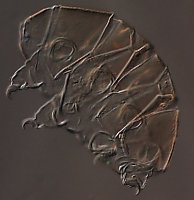
Echiniscus sp.
|
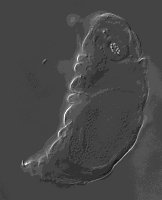
Minibiotus sp. |
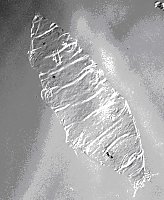
Milnesium sp. |
What Are They?
Water Bears are members of a
largely unknown phylum of invertebrate animals, the Tardigrada. The first
tardigrades were discovered in 1773 after microscopes were invented. Over 800
species have been described since then. The largest tardigrades grow to a size
of just over 1 mm, but they can easily be seen with microscopes. Tardigrade
bodies are divided into segments, roughly cylindrical and posses four pairs of
lobopodial limbs (poorly articulated limbs without joints, which are found in
soft bodied animals like Onycophorans). The limbs terminate in four to eight
claws or discs. They crawl about with a bear-like pawing motion of the legs
(that originated the name water bears) over sand grains in the seas, soil,
lichen or pieces of plant material etc.
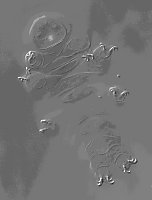
Macrobiotus cf hufelandi on
underside of glass coverslip of microscope slide, showing the claws at the end
of its legs. |
Limno-terrestrial tardigrades are
regarded as amongst the most indestructible animals that exist when they enter
their resistant state—called a tun, and can survive in extreme conditions
during cryptobiosis (the most extreme form of suspended animation).
Where are they found?
Tardigrades live in marine or
fresh water ecosystems, and also semi-aquatic terrestrial (limno-terrestrial)
environments. If you sample the mosses and lichens around your yard, you are
likely to find them. Water bears can be found in almost every type of ecosystem
around the world, from moss in tropical rain forests to the Antarctic,from the
deepest ocean to the highest mountain. They can all, however, be considered
aquatic since they must have a film of water surrounding their body to permit
gas exchange and prevent uncontrolled desiccation.
Some tardigrades exist
in environments that experience changes in temperature and water levels, so
tardigrades must be able to survive these changes or they would die. Tardigrades
have the ability to go into cryptobiosis, an extreme form of hibernation, in
order to survive the fluctuating conditions in their environment.
General Biology
Water bears feed on the fluids of
plant and animal cells, fungi etc. They are unique in having a pair of piercing
stylets which they extend out of their mouth to pierce plant cells or animal
body walls. A sucking pharyngeal bulb enables them to suck up and then ingest
the internal contents of their food. Some tardigrades eat entire live organisms,
such as rotifers, nematodes or other tardigrades.
Typically tardigrades
are dioecious, sexually reproducing with both male and females. Each has a
single gonad which lies dorsally to the gut. However, some species are
hermaphrodite and the absence of males has been reported in many populations,
the females then reproduce asexually by parthenogenesis.This gives biologists a
major problem in terms of defining a species and how they fit in evolutionary
schemes where these clones are usually regarded as a ‘dead end’
which should be quickly out competed by sexual species.
Tardigrades
express eutely, which means that the number of cells in some organs of the body
is fixed from birth, growth occurring by increase in size only and not cell
division. They do not have circulatory and respiratory systems and the excretory
system may also be minimal. The widespread distribution of tardigrades
may be attributed to the fact that their eggs, and tuns are light enough to be
distributed by wind or animals for great distances possibly in the upper
atmosphere. There is however, little evidence as yet for this. They are also now
thought to be a most ancient lineage having evolved in the Cambrian period 530
million years ago (or earlier) as newly discovered fossils date from this
period, pre-dating the famous Burgess Shale fossils of the Cambrian explosion of
animal phyla.
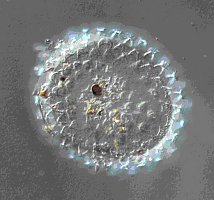
Macrobiotus cf. hufelandi
egg. |
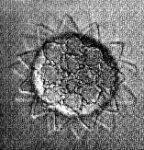
Macrobiotus cf. richtersi egg |
Cryptobiosis
The
way that tardigrades have adapted to environmental stress is to reversibly
suspend their metabolism and to effectively isolate themselves from the changes.
This state is known as cryptobiosis and is a truly death-like state. Cessation
of metabolism in other organisms is called death. Metabolism in tardigrades can
lower to less than 0.01% of normal, or be entirely undetectable and the water
content of the body may decrease to less than 1%. Tardigrades have been revived
from this state after more than 100 years and shown signs of life! However,
experiments have only shown cryptobiosis under natural conditions of 12 years
but frozen they could theoretically survive for ever! The change in
environmental conditions determine which cryptobiotic method—anhydrobiosis,
cryobiosis, osmobiosis, and anoxybiosis—will occur.
Most studies of
cryptobiosis have been done on anhydrobiosis, the form of cryptobiosis initiated
by desiccation. Tardigrades living in a limno-terrestrial habitat, such as moss
or lichens, require that they can survive long periods of dryness. Anhydrobiosis
involves an almost complete loss of body water and the animal can stay in this
state for an long period of time. Tun formation is an essential part of the
process, which can be done repeatedly throughout the life cycle, even by adults,
resulting in a body that is constricted and folded up. The limbs invaginate, the
body contracts and becomes folded.The tun formation is an active process
requiring metabolism and synthesis of a protective sugar Trehelose. After
the tun is formed further desiccation can take place in 0 % relative humidity
and the tardigrade can still survive. Revival typically takes a few hours from
natural habitats but depends upon how long the tardigrade has been in the
anhydrobiotic condition. Cryobiosis is cryptobiosis which is initiated by
a reduction in temperature to below 0 °C and involves the ordered freezing of
water within the body cells . Osmobiosis is a form of cryptobiosis initiated by
a decreased water potential due to increased solute concentration in the
surrounding solution.A reduction of the % of oxygen initiates a suspended state
in tardigrades, but is mostly not considered a form of cryptobiosis—tardigrades
in this state remain extended, turgid, and immobile but it can only last for
days before they die.
Ability to Resist Environmental Extremes
While in a state of cryptobiosis tardigrades are able
to resist environmental extremes that would be instantly letha to animals if in
the active state. In 1842, the French naturalist Doyere first discovered
tardigrades were able to withstand being heated for a few minutes to 125 °C,
later Rham in 1929 increased this figure to 150°C. Adults have been able to
survive being cooled to temperatures of almost absolute zero (-272.8°C) where
there is no free molecular vibration and so no metabolism can exist. While in
this state the organisms are also greatly resistant to X-Rays of 570,000
Roentgens (only 500 Roentgens would be fatal to a human). Water bears are also
resistant to a vacuum (like outer space), some noxious chemicals, boiling
alcohol, and pressures six time greater than the bottom of the deepest ocean
etc.
Implications and Future Research
As science obtains a better understanding of
biological processes we may have problems with previous beliefs or
understandings. This is perhaps exemplified by cryptobiosis. The issue pertains
to the definition of death and the question of whether or not tardigrades can be
dead (ametaboilic) and come back to life. The answer is no since although
metabolism may cease they maintain structural continuity and the potential for
metabolism. However, for nearly all other animals, the cessation of metabolic
activity is associated with death, and death is considered an irreversible
state. It could be suggested that life can be described as the continuity of
structural integrity with the potential of maetabolic activity and death as the
destruction of structural integrity. But even this is a problem as how can a
potential to become active be assesed? Cryptobiosis is an amazing
adaptation that may have arisen very early in the evolution of life. Scientists
have discovered how to apply this phenomenon to larger organisms. Preservation
of sperm, seeds, blood, and food is an emerging new discipline that involves
cryobiology. Cryosurgery and suspended animation also present some exciting
possibilities. The long-range implications may even include the ability to
travel long distances in space. This could occur through suspending metabolism
i.e. cryptobiosis, in humans. Recently scientists from Japan have used
the tardigrade sugar trehelose to enable them to keep a rat's heart in a fridge
at 4 degrees Celsius for 10 days and then revive it, this is exciting as at
present doctors can normally only keep a human heart alive for 4 hours before a
transplant.
Where do Tardigrades fit in with other Animals?
Tardigrades have often been called a minor phylum on
account of their small numbers of species, compared with others such as the
millions of Arthropods. However, it would be better to call them a lesser known
phylum as they appear to have been completely separate in body plan (bauplan)
since at least the Cambrian time of 530 million years ago.They also have a
world-wide distribution though some distributions indicate links to ancient
continental break-ups. Most biologists the regard tardigrades as being close to
the Arthropods probably branching off earlier from the ancestral
line. Even the most recent molecular investigations have been unable to
decide their position. Analysis of 18S rRNA by some scientists place them next
to the Onycophora and Uniramia —one of the polyphyletic Arthropod groups—while
other scientists analysing the same molecules suggest they split off before the
protosomes (Annelid/Arthropod line) even evolved! The search for the position of
the phylum Tardigrada in a natural phylogeny is still ongoing.
What about Southern Africa?
Tardigrades were first
recorded from South Africa in 1907. However, this was done like all the other
records, by experts based elsewhere.and since then there has not been as much
research undertaken compared with other areas of the world. Records from sites
(recorded now for example in 1°squares of latitude/longitude) are limited to ten
in South Africa. Other countries have less, and some countries such as Zambia
and Swaziland do not yet have records at all. Botswana and Lesotho now have
records produced by the author, in Lesotho only two sites, while Botswana has
records from 17 out of 62 of the 1° squares making it the most covered country
on the continent. Overall in Africa less than 2% of the area has been recorded
in any way. Some species such as Echiniscus africanus (first found in South
Africa) seem not been found in Southern Africa for 90 years! Some records are
dubious and other visiting experts have found unique endemic species only found
once.
Can you Collect and See Tardigrades?
Yes, taking samples for limno-terrestrial
tardigrades is extremely easy, it is mainly the processing and identification
that are difficult and time consuming. To see tardigrades you will normally need
a microscope (a hand lens could be used). A moss or lichen sample should be
soaked in water (preferably distilled or rainwater) for a few hours, then it can
be squeezed or shaken, to release tardigrades, and the water examined first
under low power such as X30 (best with a stereo microscope). If possible a
micro-pipette can be used to transfer tardigrades to a slide, which can be
looked at with a higher power compound microscope.
If you wish to help in
this area of research, you only have to find lichens or moss growing on trees or
rocks etc. scrape them off into a paper envelope or bag and send them for
identification with site data or examine them yourself.
Specialists who
are undertaking surveys involving soil/freshwater/marine invertebrates should
seek advice from the author.
References:
-
Copley, J. 1998. Putting life on hold. New
Scientist 7 November 1998: 7.
-
Copley, J. 1999. Indestructable. New
Scientist 23 October 1999: 44-46.
-
Kinchin, I. M. 1994. Biology of Tardigrades.
Portland Press, London.
-
Kristenssen, R. M. (Ed) 2001. Tardigrada. Zoologischer
Anzeiger 240: 3-4.
-
Mc Innes, S. J. and Morman, D. B. (Eds) 1996.
Tardigrade Biology. Zoological Journal of the Linnaean Society 116.
Links
Text by Roger Middleton ©
| 